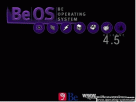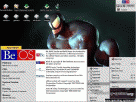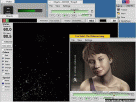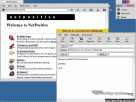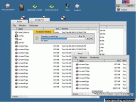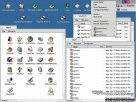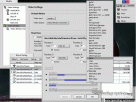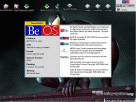705 words [ 10 Screenshots ] [ 13 Versions ] [ 3 Weblinks ] - Last update: 2023-12-22 Page created: 2004-03-04 [SB]
BeOS
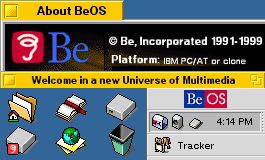 BeOS was originally developed by the company Be with the former Apple coworker Jean-Louis Gasseč for its own type of computer, the BeBox. It contains 2 power PC CPUs and was equipped with maximally with 256 Mbyte of RAM. BeOS is written from scratch and does not contain obsolete operating system design concepts. Designed as a single user operating system BeOS unfolds his optimal efficiency on multi-processor systems with several parallel running programs through it modern multi-thread based structure. BeOS basically does not run other applications that are not developed for this operating system. This operating system is only available in English, French and Japanese languages.
BeOS was originally developed by the company Be with the former Apple coworker Jean-Louis Gasseč for its own type of computer, the BeBox. It contains 2 power PC CPUs and was equipped with maximally with 256 Mbyte of RAM. BeOS is written from scratch and does not contain obsolete operating system design concepts. Designed as a single user operating system BeOS unfolds his optimal efficiency on multi-processor systems with several parallel running programs through it modern multi-thread based structure. BeOS basically does not run other applications that are not developed for this operating system. This operating system is only available in English, French and Japanese languages.
With the new version 5.0 BeOS is at the first time free of charge for private use and was named "Personal Edition". This version can be used exactly the same as the "Pro Edition" as single OS or started from any Windows partition. However the free variant is limited to a 512 MByte virtual partition in one image file for the operating system installation and further files. For network employment are a large amount of applications available.
Update: August 2001: By the assumption of Palm Inc. for 11 million dollar BeOS is not any longer commercially developed. The BeOS Community and some BeOS developers keeps the support for the future.
Update: March 2002: The BeOS Online website is a good start to download BeOS software or the BeOS 5.0 private edition which was downloaded world-wide by several sources about 1 million time. Based on the approved source code of the BeOS Personal Edition 5 the BeOS Developer edition 1.0 was developed, which contains current drivers and is further maintained by the BeOS Online team. In December 2002 the BeOS Developer Edition 1.1 was published.
OpenBeOS (OBOS) has been founded in 2001 as the official successor of BeOS as open source project. Since 2004, the operating system is continued under the name Haiku.
Another project is the commercial Zeta distribution from the company yellowTAB, later magnussoft. It is an evolved version of BeOS PE with source code from the OpenBeOS project. This operating system has not been continued since April 2007.
BlueEyedOS copies the features and the user interface from open source software. BeOS APIs were written again, so the BeOS programs remains to be executable. This operating system is based on the Linux Kernel and the XFree86 server for graphic functions. You can download on www.blueeyedos.com the demo version as an ISO image.
The Beos derivative eB-OS (Extender Beos Operating System) is based on the latest BeOS Personal Edition 5.0.3, current Haiku code, parts of BeOSMax 3.1, BeOS Developer edition 2.1 as well as drivers and applications from www.bebits.com. The last version is eB-OS 1.1 beta on bootable CD-ROM.
BeOS Field of Application
BeOS is designed for handling large amounts of data. Therefore it is suitable outstanding for Multimedia applications such as video and audio processing as well as Raytracing. By its structural short response time of 250 microseconds between individual Threads it is particularly suitable for time-critical tasks like the recording of videos in real time. The access to files takes under 10 milliseconds, depending on the used hardware. BeOS is capably to use Plug&Play devices, after the installation of new hardware the appropriate driver must be copied only in "/boot/home/config/" and the device is now useable. The object-oriented Design allows it to activate new drivers without complete restart. During the loading only the depending media module is restarted in few seconds.BeOS Area of application
support POSIXCLI: bash Shell, GUI: Tracker
JFS support
Read/Write FAT16/32, Read ext2fs and NTFS/5, HFS, UDF(DVD) and ISO-9660(CD)
optimized for the web, integrated GNU compiler
OpenGL is supported
Microkernel
preemptive multitasking
Internal Client-Server architecture
Server: Services of the oeprating system
Clients: applications, which use the oepratign system services
protected memory areas
virtual memory
Object-oriented Design
Max. file size 18 million TByte
Pervasive multi-threading architecture (operating system is divided into small threads which profit optimally from several CPUs)
BeOS System Environment
x86 CPUs or PowerPC (up to release 5.03)needs at least 32MByte RAM
64-Bit operating system
befs 64-Bit JFS file system, R/W HFS, VFAT, FAT
Symmetrical multi-processing (SMP)
Multi-processor support (up to 16 CPUs)
not designed as network server or multi-user support
Date - Version
1996, Jan. - BeOS Dr 6 (Developer Release)1996, April - BeOS Dr 7 (Developer Release)1996, Sept. - BeOS Dr 8 (Developer Release)1997, May - BeOS preview Release1998, March - BeOS 3.0 version for x861998, April - BeOS 3.0 version for PowerPC1998, June - BeOS 3.1, 1998, July - BeOS 3.2, improved hardware support (SCSI), about 800 software products available1998 Nov. - BeOS 4.0 read/write support for FAT 16/32, for x86 and PowerPC, optimized performance and better hardware compatibility1999 - BeOS 4.1 integration of the Pentium III instructions SIMD1999 June - BeOS 4.52000, March - BeOS 5.0, free of charge for private users, needs at least mbyte storage space; support for NTFS, Firewire and PCMCIA(was) planned - BeOS 6.0 with network environment BONE, Office GoBe

